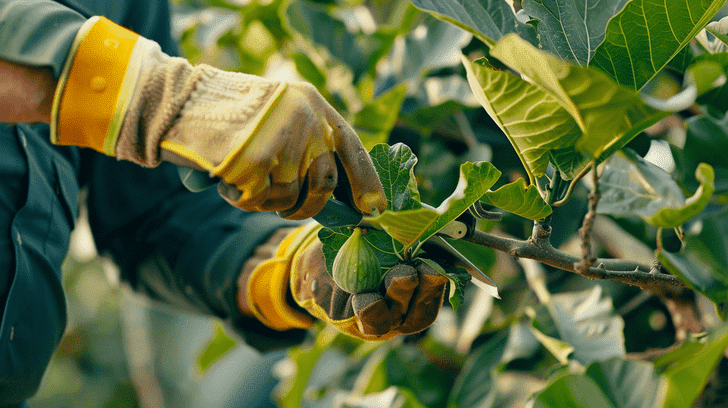When To Trim Fruit Trees: A Comprehensive Guide
When it comes to trimming your fruit trees, timing is vital. Pruning during the dormant season minimizes stress, while pruning in late winter or early spring directs energy towards fruit production and allows for more sunlight.
Summer trimming prevents overgrowth and promotes healthy development, while autumn trimming can spread disease.
To maximize fruit production and maintain tree health, it is important to prune at the right time.
By understanding the best timing for trimming your fruit trees, you’ll be one step closer to a bountiful harvest. Learn how to prune like a pro and uncover your tree’s full potential.
The Importance of Trimming Fruit Trees
Trimming fruit trees is vital to maintaining their overall health. It enables them to absorb sunlight and nutrients more efficiently, ultimately leading to a bountiful harvest.
When you prune your fruit tree, you’re allowing it to focus energy on fruit production, rather than expending it on unnecessary growth.
Pruning is best done during the dormant season, typically in late winter or early spring, to minimize stress on the tree.
By removing diseased or damaged branches, you’re promoting a strong, healthy tree structure.
Proper pruning techniques will encourage fruiting branches to grow, increasing your fruit production.
Optimal Timing for Trimming Fruit Trees
As you get ready to prune your fruit trees, it’s crucial to think about the best timing to achieve the greatest results.
You’ll need to adjust your trimming strategy based on the season, as each period presents unique opportunities and challenges.
Spring Trimming: Managing Growth and Structure
During late winter or early spring, when the tree is dormant, you’ll want to trim your fruit trees to manage their growth and structure, as this is the best timing for pruning.
Pruning in spring allows you to direct the tree’s energy towards producing fruit rather than excessive branch growth. By removing select branches, you’ll allow more sunlight to penetrate the tree, promoting healthy growth and fruit production.
This pruning technique also helps maintain a strong, balanced structure, reducing the risk of branch breakage. By pruning in spring, you’ll set your fruit tree up for a successful growing season, maximizing its energy and promoting a bountiful harvest.
Summer Trimming: Controlling Overgrowth
Summer’s heat and long days stimulate vigorous growth in fruit trees, and you’ll need to prune them regularly to prevent overgrowth and maintain their shape and productivity.
During the growing season, prune your fruit trees to control excessive growth and promote healthy development.
Summer pruning is essential to remove large branches that are growing inwards or crossing over other branches.
By pruning, you’ll encourage air circulation, reduce disease risks, and allow more sunlight to reach fruiting branches.
Use a selective pruning method to remove small branches, lateral branches, and any dead or diseased wood.
Make clean cuts to minimize pruning wounds, and prune only what’s necessary to maintain your tree’s structure.
Autumn Trimming: Risks and Considerations
When trimming fruit trees in autumn, you’ll need to weigh the benefits of pruning against the risks of stimulating new growth that may not have time to harden off before winter.
Pruning in autumn can spread disease, as cuts provide an entry point for bacterial diseases. Cutting back diseased branches is important, but it’s vital to disinfect your tools between cuts to prevent the spread of disease.
Pruning in autumn can also encourage new growth, which may not have time to harden off before the winter months. This can leave your tree vulnerable to damage.
Consider delaying pruning until late winter, when the tree is dormant, to minimize these risks.
Step-by-Step Guide to Trimming Fruit Trees
You’ll start by gathering essential tools, including a pair of sharp, clean pruning shears, loppers, and a sturdy ladder, to guarantee a safe and effective trimming process.
Next, identify the central leader, the main stem of your fruit tree, and prune any competing branches. Thin out weak or damaged branches to promote healthy growth and fruit production.
Prune your fruit tree’s spur branches, which are short, stubby branches that bear fruit, to encourage fruiting. Pruning in the summer or early winter is ideal, as fruit trees bear fruit on one-year-old wood.
Remove any crossing or rubbing branches to prevent damage and disease.
Special Considerations for Pruning Diseased Trees
When pruning diseased fruit trees, you’ll need to take extra precautions to prevent the spread of disease and promote healthy growth.
First, you’ll identify the symptoms of disease and sanitize your tools to prevent transmission.
Next, you’ll make strategic cuts to remove infected areas, carefully considering the tree’s structure and growth patterns.
Identifying Disease Symptoms
Diseased fruit trees often display distinct symptoms that can guide your pruning strategy.
Recognizing these signs is vital for effective disease management. When pruning diseased trees, it’s important to identify the symptoms to target the disease effectively.
Here are three common signs to look out for:
- Visible cankers: Dead or dying areas on the bark, often accompanied by cracking or oozing.
- Blighted branches: Wilting, yellowing, or dying leaves and stems, often caused by fire blight or other bacterial infections.
- Wound infections: Cracks or wounds on the bark that provide an entry point for pathogenic bacteria, leading to further disease spread.
Sanitizing Tools to Prevent Spread
Your pruning tools can become contaminated with pathogens from infected trees, spreading disease to healthy trees if not properly sanitized between cuts. To prevent this, you must sterilize your tools between each cut.
Dip your pruning shears or loppers in a solution of 1 part bleach to 10 parts water, or use a dedicated sterilizing solution. This will kill any pests or diseases that may be present on your tools.
When pruning diseased branches, make clean cuts just above a node, and remove all pruned branches from the area to prevent the disease from spreading. By sanitizing your tools and making careful cuts, you can help prevent the spread of disease from tree to tree.
Strategic Cuts to Remove Infected Areas
To effectively remove infected areas, you’ll need to make strategic cuts that prioritize the removal of diseased wood while preserving as much healthy tissue as possible.
This requires careful planning and execution to prevent the spread of disease.
Here are the essential steps to follow:
- Identify infected branches: Look for dead, diseased, or damaged branches and remove them completely to prevent the disease from spreading.
- Make clean cuts: Prune infected areas, making clean cuts just above a node or bud, using sanitized tools to prevent further infection.
- Remove all infected material: Dispose of all infected branches and debris to prevent re-infection.
FAQ
]
What month is the best time to prune fruit trees?
Prune your fruit trees during their dormant season, which typically falls between late winter and early spring, to minimize stress and promote healthy growth. This allows the tree to conserve energy and direct it towards fruit production.
Here are the key benefits of pruning during this time:
- Reduced risk of disease: Pruning during the dormant season reduces the risk of disease, as most diseases are more prevalent during the growing season.
- Improved air circulation: Pruning removes branches that can create a humid microclimate, promoting air circulation and reducing disease risk.
- Better fruit production: Pruning during the dormant season encourages the tree to focus energy on fruit production, leading to a bountiful harvest.
Is it better to prune fruit trees in fall or spring?
When deciding between fall and spring pruning, consider that each season has its advantages, depending on your specific climate and tree variety. If you live in an area with harsh winters, pruning in the fall can help protect your fruit trees from damage. However, this can also stimulate new growth, making your tree more susceptible to winter damage.
Pruning in the spring, just before new growth begins, allows you to see the tree’s structure more clearly and make more precise pruning cuts. Additionally, spring pruning can help promote healthy growth and fruit production.
Regardless of the season, following proper pruning steps is crucial to avoid damaging your tree. In general, late winter is a good time to prune fruit trees, as it allows you to prune before new growth begins.
What happens if you prune fruit trees too early?
If you prune your fruit trees too early, you may inadvertently stimulate new growth that can leave your trees vulnerable to winter damage or disease. This is because pruning stimulates the tree’s growth, and if done too early, the new growth may not have time to harden off before winter, making it more susceptible to damage.
Here are three potential consequences of early pruning:
- Winter kill: New growth may not be able to withstand cold temperatures, leading to winter kill.
- Disease susceptibility: Fresh cuts can provide an entry point for diseases, which can spread quickly in the tree.
- Reduced fruit production: Early pruning can divert the tree’s energy towards new growth, rather than fruit production.
Should you cut the tops off fruit trees?
Cutting the tops off fruit trees, a process called heading, can be beneficial in certain situations, but it’s not a technique you should use casually. When done correctly, heading can help control the tree’s shape, promote healthy growing, and increase fruit production.
However, if not done properly, it can cause more harm than good. You should only cut the top off a fruit tree if it’s necessary to remove dead or damaged branches. This type of pruning can also encourage bushy growth, making it ideal for trees that require trimming to maintain a specific shape.
Conclusion
As you prune your fruit tree, remember that every cut is a deliberate decision, shaping the tree’s future like a master sculptor molding clay.
By following these guidelines, you’ll reveal your tree’s full potential, and a bountiful harvest will be your reward.
With pruning, you’re not just trimming branches – you’re cultivating life.







